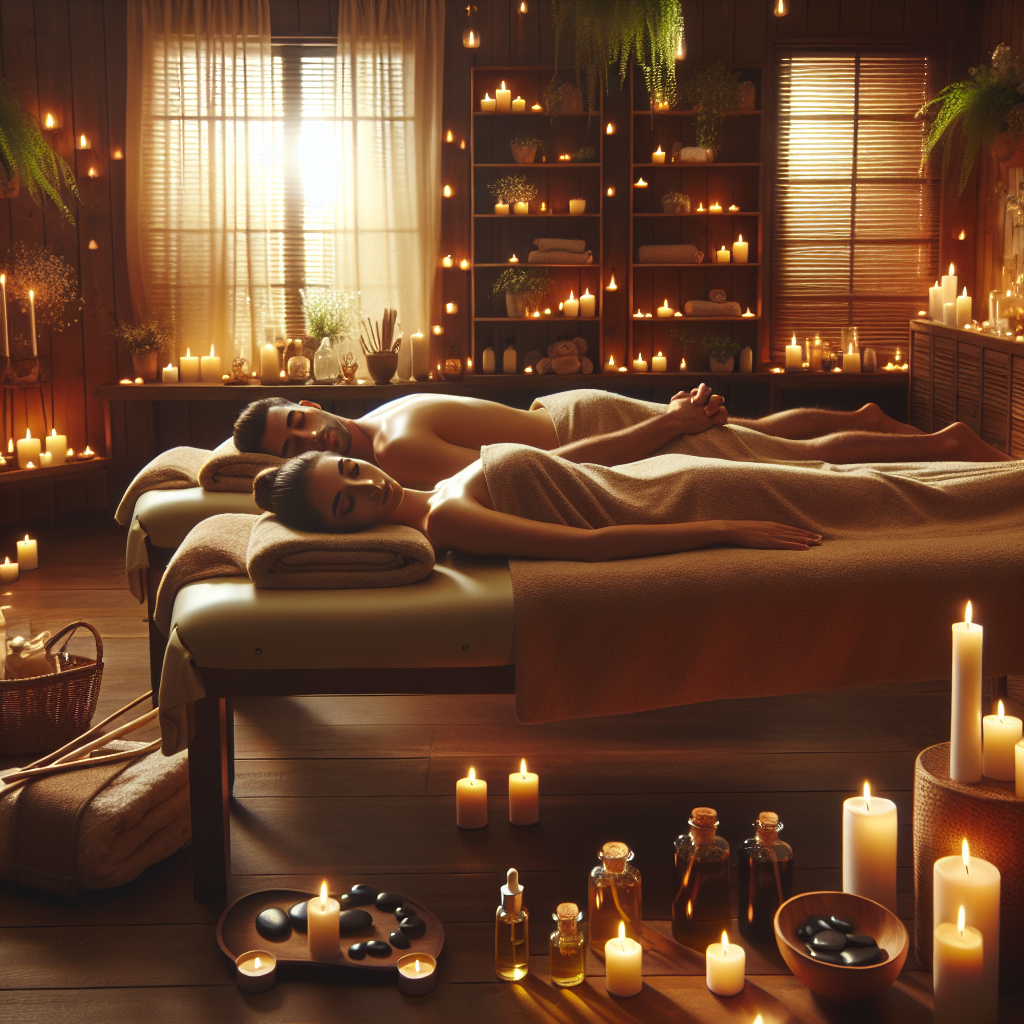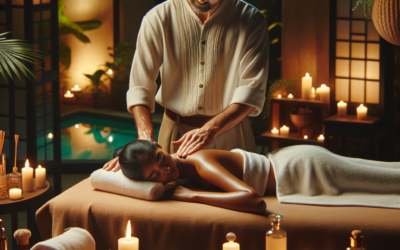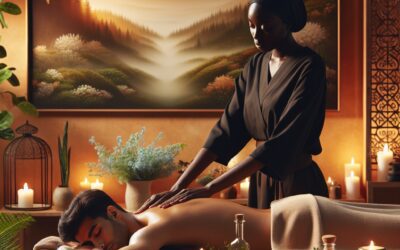Introduction
Table of Contents
A spa is a dedicated venue that offers a variety of health and wellness treatments in a relaxing and therapeutic environment. These treatments often include massages, facials, body scrubs, hydrotherapy, and various personalized skincare services. Spas are designed to promote relaxation, rejuvenation, and overall well-being, often incorporating holistic practices and natural products. They can range from small day spas that offer a select menu of services to large resort and destination spas that provide a wide array of treatments along with accommodations and other amenities. The concept of the spa has evolved over centuries, with roots in the healing traditions of various cultures, including the Roman baths and the Turkish hammams.
The Ultimate Guide to Spa Etiquette: Tips for a Relaxing Visit
Title: The Ultimate Guide to Spa Etiquette: Tips for a Relaxing Visit
Embarking on a spa visit can be a rejuvenating experience that restores balance to both mind and body. However, to fully enjoy the serenity and benefits of a spa, understanding and adhering to certain etiquette can enhance not only your relaxation but also that of others. This guide will provide you with essential tips to ensure your visit is as tranquil and enjoyable as possible.
First and foremost, punctuality is key. Arriving at least 15 minutes early allows you to check in, change into your robe, and start slowing down. This buffer also gives you ample time to familiarize yourself with the facilities and unwind before your treatment begins. Late arrivals often result in shortened sessions, as therapists typically have a schedule to adhere to, and it’s important to respect the time of both the staff and other guests.
Upon arrival, it’s advisable to communicate any preferences or special needs you may have. Whether it’s a health condition, allergy, or a request for a specific therapist, clear communication will enable the spa staff to tailor your experience to your needs. Additionally, disclosing any discomfort or areas that require special attention during treatments will ensure that your experience is both safe and personalized.
Silence is golden in the realm of spas. Most guests seek a quiet escape from the hustle and bustle of daily life, so it’s important to keep conversations at a low volume. Mobile phones and other electronic devices should be silenced or left in lockers to maintain the peaceful ambiance. This digital disconnection not only respects the quiet space but also allows you and others to fully immerse in the restorative spa experience.
Hygiene is another cornerstone of spa etiquette. Showering before treatments is not only respectful to the therapists but also enhances your own experience by preparing your skin for oils and lotions. Additionally, using facilities such as saunas and steam rooms requires adherence to cleanliness protocols, including sitting on towels and wearing appropriate attire as directed by the spa.
When it comes to gratuity, it’s customary to leave a tip for the therapist who provided your service. The amount can vary, but typically ranges from 15% to 20% of the treatment cost. Some spas include gratuity in their pricing or offer envelopes at the front desk to discreetly leave a tip. If you’re unsure about the spa’s policy, don’t hesitate to ask the receptionist for guidance.
Lastly, after your treatment, it’s important to take time to transition back to reality gently. Rushing out can jolt you out of your relaxed state, so utilize relaxation rooms or lounges if they are available. Hydrate with water or herbal tea to help flush out toxins and extend the benefits of your treatment.
In conclusion, spa visits can be a sanctuary for personal rejuvenation, and by following these etiquette tips, you can ensure a harmonious and restful experience. Remember to arrive early, communicate openly, respect the quiet environment, maintain hygiene, handle gratuity appropriately, and ease back into your day. With these practices in place, you’ll be well on your way to achieving the ultimate relaxation that a spa visit promises.
Top 10 Spa Treatments for Ultimate Relaxation and Rejuvenation

Title: Top 10 Spa Treatments for Ultimate Relaxation and Rejuvenation
In the pursuit of tranquility and well-being, spa treatments stand as sanctuaries of relaxation and rejuvenation. Amidst the myriad of therapies available, certain treatments have gained prominence for their effectiveness in soothing the mind and revitalizing the body. Here, we explore the top ten spa treatments that are celebrated for providing the ultimate relaxation and rejuvenation experience.
Firstly, Swedish massage is a classic therapy that has become a cornerstone in the spa industry. Renowned for its gentle yet firm approach, this massage technique employs long strokes, kneading, and circular movements to relieve muscle tension and enhance blood circulation. It serves as an ideal introduction for those new to massage, offering a serene escape from the stresses of daily life.
Following closely is the deep tissue massage, a more intense form of bodywork that targets the deeper layers of muscle and connective tissue. This treatment is particularly beneficial for individuals with chronic muscle pain or those recovering from injuries. It aids in breaking down knots and improving range of motion, ensuring a deep sense of relief and recovery.
Another popular choice is the hot stone massage, where smooth, heated stones are placed on key points of the body. The warmth from the stones penetrates deeply, melting away tension and promoting a unique sense of comfort. This treatment not only eases tight muscles but also enhances mental serenity, making it a favorite for those seeking a holistic experience.
Aromatherapy massage introduces the power of essential oils to the healing touch of massage. By selecting oils that align with the individual’s needs, whether it be relaxation, energy, or balance, this treatment harmonizes the senses and nurtures the soul. The inhalation of therapeutic scents combined with the soothing massage strokes creates a multi-sensory pathway to tranquility.
Facials are not to be overlooked in the realm of spa treatments. These skin-nourishing sessions can range from hydrating and anti-aging to detoxifying and brightening, depending on the skin’s requirements. Utilizing various techniques and products, facials leave the skin glowing, refreshed, and revitalized, complementing the overall sense of well-being.
Body scrubs exfoliate the skin, removing dead cells and promoting cell regeneration. Often incorporating natural ingredients like salt, sugar, or coffee, these scrubs not only smooth and soften the skin but also stimulate lymphatic drainage and improve circulation. The result is a rejuvenated body that feels invigorated and polished to perfection.
Body wraps are another transformative spa treatment, designed to detoxify and nourish the body. With a variety of wraps available, including seaweed, mud, or clay, these treatments draw out impurities and provide essential minerals to the skin. Wrapped in warmth, clients often experience a cocoon-like sensation that promotes deep relaxation and a sense of renewal.
Reflexology focuses on applying pressure to specific points on the feet, hands, or ears, which correspond to different body organs and systems. This treatment is believed to restore energy flow and balance within the body, leading to a reduction in stress and the promotion of healing.
For those seeking a more exotic touch, Thai massage combines acupressure, Indian Ayurvedic principles, and assisted yoga postures. This dynamic treatment stretches and loosens the body, enhancing flexibility and energy levels. It is an invigorating experience that leaves one feeling both relaxed and energized.
Lastly, the Shiatsu massage, originating from Japan, employs rhythmic pressure along the body’s meridians or energy pathways. This technique aims to restore the flow of vital energy, or qi, within the body. Shiatsu is a deeply relaxing treatment that also works to alleviate various ailments, contributing to a harmonious state of health.
In conclusion, these top ten spa treatments offer a diverse array of options for those seeking to unwind and rejuvenate. Whether one prefers the gentle touch of a Swedish massage or the invigorating pressure of Shiatsu, each therapy promises a journey towards ultimate relaxation and a renewed sense of vitality. As the world increasingly recognizes the importance of self-care, these spa treatments stand as pillars of holistic health and well-being.
The Benefits of Regular Spa Visits for Stress Relief and Wellness
The Benefits of Regular Spa Visits for Stress Relief and Wellness
In the hustle and bustle of modern life, stress has become a common companion for many. The relentless pace at which we live can take a toll on our physical and mental well-being. Amidst this backdrop, regular spa visits emerge as a sanctuary for stress relief and wellness, offering a respite from the daily grind and a chance to rejuvenate the mind and body.
The spa experience is designed to cater to the senses, creating an environment that promotes relaxation from the moment one steps in. The soothing ambiance, characterized by soft lighting, tranquil music, and aromatic scents, sets the stage for a journey towards serenity. This multisensory approach is not merely aesthetic; it is rooted in the understanding that our surroundings can significantly influence our internal state, paving the way for deeper relaxation.
One of the primary benefits of spa treatments is the facilitation of relaxation and stress reduction. Massage therapy, a staple in most spas, is renowned for its ability to alleviate tension in the muscles. Through skilled manipulation of the body’s soft tissues, massage therapists help to release knots and stiffness, leading to a sense of physical ease that often translates into mental calmness. Moreover, the human touch involved in massage has been shown to trigger the release of endorphins, the body’s natural feel-good hormones, which further enhances the stress-relieving effects.
Beyond massage, spas offer a variety of treatments that can aid in detoxification and promote overall health. Hydrotherapy, for instance, utilizes water in various forms and temperatures to stimulate blood circulation and lymphatic drainage, aiding in the removal of toxins from the body. Saunas and steam rooms, too, are effective in opening up the pores and encouraging a cleansing sweat, while also providing a warm environment that helps to relax muscles and reduce stress.
Regular spa visits also contribute to better sleep patterns. The deep relaxation achieved through spa treatments can help to reset the body’s sleep-wake cycle, making it easier to fall asleep and stay asleep. Good quality sleep is essential for the body’s repair processes and for maintaining a balanced mood, which in turn can help to manage stress levels more effectively.
Furthermore, the act of taking time out for oneself to visit a spa is a form of self-care that can have psychological benefits. It signals a commitment to one’s health and well-being, fostering a sense of self-worth and prioritization of personal wellness. This psychological aspect is crucial, as stress often arises when individuals feel overwhelmed by external demands and neglect their own needs.
In addition to the individual benefits, regular spa visits can also have a positive impact on social well-being. Many people enjoy spa experiences with friends or loved ones, which can strengthen relationships and provide a shared space for relaxation and connection. The social interaction inherent in such outings can be a powerful antidote to stress, as it provides emotional support and a sense of belonging.
In conclusion, the benefits of regular spa visits are manifold, encompassing physical relaxation, mental calm, detoxification, improved sleep, self-care, and social well-being. As a holistic approach to stress relief and wellness, the spa offers a therapeutic escape from the pressures of daily life, allowing individuals to recharge and emerge refreshed and better equipped to handle the challenges that lie ahead. In recognizing the importance of such practices, we can better support our journey towards a balanced and healthy lifestyle.
How to Choose the Perfect Spa: Factors to Consider for a Blissful Experience
Choosing the perfect spa can be a delightful yet daunting task, given the plethora of options available to those seeking a serene escape from the hustle and bustle of daily life. A blissful spa experience can rejuvenate the mind, body, and soul, but to ensure that one’s expectations are met, several factors must be taken into consideration before making a reservation.
First and foremost, it is essential to determine the purpose of your spa visit. Are you looking for a place to unwind and relax, or are you in need of therapeutic treatments to address specific health concerns? Understanding your objectives will guide you in selecting a spa that specializes in the services that match your needs. For instance, a day spa may offer a variety of relaxation treatments such as massages and facials, while a medical spa might focus on more specialized procedures under the supervision of healthcare professionals.
Another critical factor to consider is the reputation of the spa. With the advent of the internet, it has become easier to research and read reviews from previous guests. Look for feedback regarding the quality of services, the professionalism of the staff, and the overall cleanliness of the facility. A reputable spa should have a track record of maintaining high standards and consistently delivering exceptional customer experiences.
The location of the spa is also a significant aspect to ponder. Whether you prefer a local establishment that is easily accessible or a secluded retreat far from the madding crowd, the setting can greatly influence your level of relaxation. Some may find solace in a spa nestled in the heart of nature, offering tranquil views and the soothing sounds of the environment, while others might opt for an urban spa that combines the convenience of city life with an oasis of calm.
The range of services and treatments available is another point of consideration. A comprehensive menu that includes a variety of massages, facials, body treatments, and wellness programs allows for a more personalized spa experience. It is also beneficial to inquire about the products used during treatments. Many spas now emphasize organic and natural products to cater to health-conscious clients and those with sensitive skin.
Moreover, the expertise and qualifications of the spa staff play a pivotal role in ensuring a safe and enjoyable experience. Certified and experienced therapists are better equipped to provide high-quality treatments and can offer advice tailored to your individual needs. Do not hesitate to ask about the training and certification of the staff when researching potential spas.
Lastly, the ambiance of the spa contributes significantly to the overall experience. A serene and inviting atmosphere, characterized by soothing music, soft lighting, and pleasant aromas, can enhance the therapeutic effects of spa treatments. The design and decor of the spa should promote a sense of peace and relaxation, allowing you to fully immerse yourself in the experience.
In conclusion, selecting the perfect spa requires careful consideration of various factors, including the purpose of your visit, the spa’s reputation, location, range of services, staff qualifications, and ambiance. By taking the time to evaluate these elements, you can ensure that your spa experience will be nothing short of blissful. Remember that the ideal spa is one that aligns with your personal preferences and leaves you feeling refreshed, revitalized, and ready to face the world with renewed vigor.
The Evolution of Spa Services: From Ancient Rituals to Modern Luxuries
The Evolution of Spa Services: From Ancient Rituals to Modern Luxuries
The concept of the spa, a sanctuary dedicated to health and well-being through various treatments and therapies, has been a part of human culture for millennia. The origins of spa services can be traced back to ancient civilizations, where the healing properties of water were revered and integrated into daily life. Over time, these practices have evolved, reflecting the changing attitudes, technologies, and cultural values of societies, culminating in the modern luxuries we associate with spa services today.
In ancient times, communal baths were a staple in societies such as Rome, Greece, and Japan. The Greeks were known for their gymnasiums and palaestras, where bathing was a crucial part of the physical and intellectual grooming process. Similarly, the Romans developed sophisticated thermal baths, utilizing their engineering prowess to create aqueducts and heating systems that allowed for public and private baths to flourish across their empire. These baths were not merely places for cleanliness; they were centers of social interaction, relaxation, and even political discourse.
As the centuries progressed, the tradition of bathing and spa services took on new forms. During the Middle Ages, the emphasis on public baths diminished in Europe due to concerns about disease and morality. However, the Renaissance period saw a revival of interest in the human body and its care, leading to a resurgence of spa culture. This was particularly evident in towns known for their mineral-rich waters, such as Spa in Belgium, from which the modern word “spa” is derived. These towns became destinations for those seeking healing and rejuvenation, with visitors partaking in drinking and bathing in the mineral waters, believed to have curative powers.
The industrial revolution and the subsequent Victorian era brought about a new wave of spa development. With the advent of railroads and the growth of the middle class, spa towns became more accessible, and the concept of the spa as a retreat for health and relaxation gained popularity. During this period, the focus on hydrotherapy intensified, and establishments began to offer a wider range of treatments, including massages, mud baths, and other body therapies.
In the 20th century, the spa industry continued to expand and diversify. The rise of holistic health movements and a growing awareness of the importance of stress management contributed to the proliferation of spa services. Spas began to incorporate a variety of practices from around the world, such as Ayurveda from India, acupuncture from China, and aromatherapy from Europe, reflecting a more global approach to wellness.
Today, modern spas are temples of tranquility, offering an extensive array of services that cater to the body, mind, and spirit. They combine ancient healing traditions with cutting-edge technology and luxurious amenities. From thermal mineral springs to state-of-the-art cryotherapy, the modern spa experience is designed to provide the ultimate in relaxation and rejuvenation. Personalized treatments, wellness programs, and beauty services are tailored to meet the individual needs of each client, ensuring a holistic approach to health.
The evolution of spa services from ancient rituals to modern luxuries demonstrates humanity’s enduring quest for balance and well-being. As we continue to navigate the complexities of contemporary life, the spa remains a haven where one can retreat from the pressures of the outside world and engage in self-care practices that have been refined over centuries. The spa industry’s ability to adapt and innovate ensures that it will continue to thrive, offering sanctuary and healing to those who seek it.
Creating a Spa-Like Atmosphere at Home: Essentials for a DIY Spa Day
Creating a Spa-Like Atmosphere at Home: Essentials for a DIY Spa Day
In the hustle and bustle of modern life, finding time to unwind and pamper oneself is essential for maintaining balance and well-being. While visiting a professional spa can be a luxurious treat, it is not always feasible due to time constraints or budget considerations. Fortunately, with a few simple touches, you can transform your home into a serene sanctuary that rivals the tranquility of a spa. Here’s how to curate a spa-like atmosphere and enjoy a rejuvenating DIY spa day within the comfort of your own abode.
First and foremost, cleanliness and organization are the cornerstones of a relaxing environment. Begin by decluttering the space you intend to use, typically the bathroom, to create a calming and uncluttered area. This step is crucial as it sets the stage for a stress-free experience. Once the space is tidy, deep clean surfaces to ensure that your at-home spa is as hygienic and inviting as a professional establishment.
Next, consider the sensory experiences that define a spa. Soft lighting is paramount in creating a soothing ambiance. Dim the lights or use candles to provide a gentle glow that encourages relaxation. The flicker of candlelight not only softens the room but also adds a touch of warmth and intimacy. Additionally, aromatherapy plays a significant role in setting the mood. Essential oils such as lavender, eucalyptus, or chamomile can be used in an oil diffuser or added to bathwater to engage the olfactory senses and promote a sense of calm.
The auditory experience should not be overlooked. Gentle, instrumental music or the sounds of nature can be played in the background to further enhance the spa-like atmosphere. The right acoustic backdrop can transport you to a state of zen, allowing your mind to drift away from daily stresses.
To mimic the pampering treatments of a spa, gather all the necessary tools and products for your DIY spa day. This includes plush towels, a cozy bathrobe, slippers, and an assortment of skincare products. Face masks, exfoliating scrubs, and rich moisturizers are essential for a full-body treatment that leaves your skin feeling refreshed and rejuvenated. For an added touch of luxury, warm your towels on a radiator or in the dryer prior to use.
The centerpiece of any spa day is the bath. Elevate your bathing experience by adding bath salts, oils, or bubbles to create a therapeutic soak. Not only do these additions provide a delightful sensory experience, but they can also offer benefits such as muscle relaxation and improved skin hydration.
Lastly, remember that a spa day is not just about physical relaxation but also mental repose. Allocate uninterrupted time for your at-home spa experience, ensuring that you can fully immerse yourself without distractions. This might mean turning off your phone, putting a ‘Do Not Disturb’ sign on the door, or arranging for a time when you won’t be interrupted.
In conclusion, creating a spa-like atmosphere at home is about more than just the physical space; it’s about crafting an experience that engages all the senses and fosters relaxation. By meticulously preparing your environment and selecting the right treatments, you can indulge in a DIY spa day that rejuvenates both the body and the mind. With these essentials, you’ll find that a slice of spa serenity can be achieved without ever stepping outside your door.
Q&A
1. What is a spa?
A spa is a facility that offers health and wellness treatments through various services such as massages, facials, body treatments, and water-based therapies.
2. What are the benefits of going to a spa?
Benefits of spa treatments include relaxation, stress relief, improved circulation, detoxification, skin rejuvenation, and relief from muscle tension and pain.
3. What is a day spa?
A day spa is a spa facility that offers a variety of services for health and beauty that can be enjoyed during a single day visit, without overnight accommodations.
4. What is the difference between a spa and a medispa?
A spa typically offers wellness treatments like massages, facials, and body treatments, while a medispa, or medical spa, offers more specialized treatments that are often supervised by a medical professional, such as laser treatments, injectables, and medical-grade skin care treatments.
5. What should one wear to a spa?
One should wear comfortable clothing to a spa. Most spas provide a robe and slippers to wear during your visit. For treatments like massages or body treatments, you may be asked to disrobe to your comfort level.
6. How should one prepare for a spa visit?
To prepare for a spa visit, it’s recommended to arrive early to fill out any necessary paperwork and start relaxing. It’s also advisable to shower before treatments, avoid eating a heavy meal right before, and communicate any preferences or allergies to the spa staff.
Conclusion
Spas offer a variety of services designed to promote relaxation, wellness, and beauty. They can provide significant benefits including stress reduction, pain relief, improved circulation, and rejuvenation of the skin and body. Regular visits to a spa may contribute to better mental and physical health, enhanced well-being, and a greater sense of balance and tranquility.





0 Comments